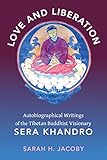Love and liberation : autobiographical writings of the Tibetan Buddhist visionary Sera Khandro / Sarah H. Jacoby.
Material type: TextPublisher number: MWT11864344Publisher: New York : Columbia University Press, [2014]Description: 1 online resource (xxv, 422 pages .)Content type:
TextPublisher number: MWT11864344Publisher: New York : Columbia University Press, [2014]Description: 1 online resource (xxv, 422 pages .)Content type: - text
- computer
- online resource
- 0231519532
- 9780231519533
- 0231147694
- 9780231147699
- Buddhist women -- China -- Amdo (Region) -- Biography
- Women religious leaders -- China -- Amdo (Region) -- Biography
- Andere Religionen
- Asia-Pacific
- Culture and History of non-European Territories
- History
- FOREIGN LANGUAGE STUDY -- Multi-Language Phrasebooks
- LANGUAGE ARTS & DISCIPLINES -- Alphabets & Writing Systems
- LANGUAGE ARTS & DISCIPLINES -- Grammar & Punctuation
- LANGUAGE ARTS & DISCIPLINES -- Linguistics -- General
- LANGUAGE ARTS & DISCIPLINES -- Readers
- LANGUAGE ARTS & DISCIPLINES -- Spelling
- RELIGION -- Buddhism -- Tibetan
- Buddhist women
- Women religious leaders
- China -- Amdo (Region)
- 294.3/923092 B 23
- BQ942.D427 J33 2014
| Item type | Home library | Collection | Call number | Materials specified | Status | Date due | Barcode | |
|---|---|---|---|---|---|---|---|---|
 Electronic-Books
Electronic-Books
|
OPJGU Sonepat- Campus | E-Books EBSCO | Available |
Includes bibliographical references and index.
Print version record.
Frontmatter -- Contents -- List of Illustrations -- Preface and Acknowledgments -- Technical Note on Tibetan and Sanskrit Words -- Abbreviations -- Chronology -- Maps -- Introduction -- 1. THE LIFE AND TIMES OF SERA KHANDRO -- 2. A GUEST IN THE SACRED LAND OF GOLOK -- 3. ḌĀKINĪ DIALOGUES -- 4. SACRED SEXUALITY -- 5. LOVE BETWEEN METHOD AND INSIGHT -- EPILOGUE: Love After Death -- Spelling of Key Tibetan Names and Terms -- Notes -- Bibliography -- Index
Love and Liberation reads the autobiographical and biographical writings of one of the few Tibetan Buddhist women to record the story of her life. Sera Khandro Künzang Dekyong Chönyi Wangmo (also called Dewé Dorjé, 1892-1940) was extraordinary not only for achieving religious mastery as a Tibetan Buddhist visionary and guru to many lamas, monastics, and laity in the Golok region of eastern Tibet, but also for her candor. This book listens to Sera Khandro's conversations with land deities, dakinis, bodhisattvas, lamas, and fellow religious community members whose voices interweave with her own to narrate what is a story of both love between Sera Khandro and her guru, Drimé Özer, and spiritual liberation. Sarah H. Jacoby's analysis focuses on the status of the female body in Sera Khandro's texts, the virtue of celibacy versus the expediency of sexuality for religious purposes, and the difference between profane lust and sacred love between male and female tantric partners. Her findings add new dimensions to our understanding of Tibetan Buddhist consort practices, complicating standard scriptural presentations of male subject and female aide. Sera Khandro depicts herself and Drimé Özer as inseparable embodiments of insight and method that together form the Vajrayana Buddhist vision of complete buddhahood. By advancing this complementary sacred partnership, Sera Khandro carved a place for herself as a female virtuoso in the male-dominated sphere of early twentieth-century Tibetan religion.
In English.
De Gruyter allows unlimited users access at one time (10.07.18).
eBooks on EBSCOhost EBSCO eBook Subscription Academic Collection - Worldwide
There are no comments on this title.

